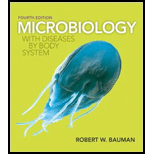
1.
Disease-causing microbes are termed as pathogens. All microorganisms are not harmful to human beings. Some of them are beneficial as well. Some bacteria cause serious illnesses in human beings and such kind of microbes are categorized under the term pathogen. The variety of pathogenic microorganisms includes bacteria, viruses, protozoa,
2.
Disease-causing microbes are termed as pathogens. All microorganisms are not harmful to human beings. Some of them are beneficial as well. Some bacteria cause serious illnesses in human beings and such kind of microbes are categorized under the term pathogen. The variety of pathogenic microorganisms include bacteria, viruses, protozoa, fungi, and worms. The disease occurred by the infection of pathogens is called pathogenic disease. Each disease causes significant signs and symptoms.
3.
Disease-causing microbes are termed as pathogens. All microorganisms are not harmful to human beings. Some of them are beneficial as well. Some bacteria cause serious illnesses in human beings and such kind of microbes are categorized under the term pathogen. The variety of pathogenic microorganisms include bacteria, viruses, protozoa, fungi, and worms. The disease occurred by the infection of pathogens is called pathogenic disease. Each disease causes significant signs and symptoms.
4.
Disease-causing microbes are termed as pathogens. All microorganisms are not harmful to human beings. Some of them are beneficial as well. Some bacteria cause serious illnesses in human beings and such kind of microbes are categorized under the term pathogen. The variety of pathogenic microorganisms include bacteria, viruses, protozoa, fungi, and worms. The disease occurred by the infection of pathogens is called pathogenic disease. Each disease causes significant signs and symptoms.
5.
Disease-causing microbes are termed as pathogens. All microorganisms are not harmful to human beings. Some of them are beneficial as well. Some bacteria cause serious illnesses in human beings and such kind of microbes are categorized under the term pathogen. The variety of pathogenic microorganisms include bacteria, viruses, protozoa, fungi, and worms. The disease occurred by the infection of pathogens is called pathogenic disease. Each disease causes significant signs and symptoms.
Want to see the full answer?
Check out a sample textbook solution
Chapter 21 Solutions
Microbiology with Diseases by Body System (4th Edition)
- please fill in the empty sports, thank you!arrow_forwardIn one paragraph show how atoms and they're structure are related to the structure of dna and proteins. Talk about what atoms are. what they're made of, why chemical bonding is important to DNA?arrow_forwardWhat are the structure and properties of atoms and chemical bonds (especially how they relate to DNA and proteins).arrow_forward
- The Sentinel Cell: Nature’s Answer to Cancer?arrow_forwardMolecular Biology Question You are working to characterize a novel protein in mice. Analysis shows that high levels of the primary transcript that codes for this protein are found in tissue from the brain, muscle, liver, and pancreas. However, an antibody that recognizes the C-terminal portion of the protein indicates that the protein is present in brain, muscle, and liver, but not in the pancreas. What is the most likely explanation for this result?arrow_forwardMolecular Biology Explain/discuss how “slow stop” and “quick/fast stop” mutants wereused to identify different protein involved in DNA replication in E. coli.arrow_forward
- Molecular Biology Question A gene that codes for a protein was removed from a eukaryotic cell and inserted into a prokaryotic cell. Although the gene was successfully transcribed and translated, it produced a different protein than it produced in the eukaryotic cell. What is the most likely explanation?arrow_forwardMolecular Biology LIST three characteristics of origins of replicationarrow_forwardMolecular Biology Question Please help. Thank you For E coli DNA polymerase III, give the structure and function of the b-clamp sub-complex. Describe how the structure of this sub-complex is important for it’s function.arrow_forward
 Human Anatomy & Physiology (11th Edition)BiologyISBN:9780134580999Author:Elaine N. Marieb, Katja N. HoehnPublisher:PEARSON
Human Anatomy & Physiology (11th Edition)BiologyISBN:9780134580999Author:Elaine N. Marieb, Katja N. HoehnPublisher:PEARSON Biology 2eBiologyISBN:9781947172517Author:Matthew Douglas, Jung Choi, Mary Ann ClarkPublisher:OpenStax
Biology 2eBiologyISBN:9781947172517Author:Matthew Douglas, Jung Choi, Mary Ann ClarkPublisher:OpenStax Anatomy & PhysiologyBiologyISBN:9781259398629Author:McKinley, Michael P., O'loughlin, Valerie Dean, Bidle, Theresa StouterPublisher:Mcgraw Hill Education,
Anatomy & PhysiologyBiologyISBN:9781259398629Author:McKinley, Michael P., O'loughlin, Valerie Dean, Bidle, Theresa StouterPublisher:Mcgraw Hill Education, Molecular Biology of the Cell (Sixth Edition)BiologyISBN:9780815344322Author:Bruce Alberts, Alexander D. Johnson, Julian Lewis, David Morgan, Martin Raff, Keith Roberts, Peter WalterPublisher:W. W. Norton & Company
Molecular Biology of the Cell (Sixth Edition)BiologyISBN:9780815344322Author:Bruce Alberts, Alexander D. Johnson, Julian Lewis, David Morgan, Martin Raff, Keith Roberts, Peter WalterPublisher:W. W. Norton & Company Laboratory Manual For Human Anatomy & PhysiologyBiologyISBN:9781260159363Author:Martin, Terry R., Prentice-craver, CynthiaPublisher:McGraw-Hill Publishing Co.
Laboratory Manual For Human Anatomy & PhysiologyBiologyISBN:9781260159363Author:Martin, Terry R., Prentice-craver, CynthiaPublisher:McGraw-Hill Publishing Co. Inquiry Into Life (16th Edition)BiologyISBN:9781260231700Author:Sylvia S. Mader, Michael WindelspechtPublisher:McGraw Hill Education
Inquiry Into Life (16th Edition)BiologyISBN:9781260231700Author:Sylvia S. Mader, Michael WindelspechtPublisher:McGraw Hill Education





